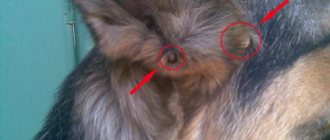4.5 / 5 ( 2 voices)
Castration or sterilization of a dog is an important and responsible step for every owner. The owners see the operation as something scary and unpredictable. Before deciding on surgical intervention, you need to understand the difference between castration and sterilization, and know all the pros and cons of this procedure.
How is a German Shepherd castrated?
German Shepherd castration is performed under general anesthesia. Its essence is to remove the testicles of a male dog and the ovaries (sometimes along with the uterus) of a female dog. This happens by cutting the scrotum. The operation for bitches is a little more complicated, but in general such operations are considered absolutely ordinary if there are no contraindications.
The operation does not take much time, on average it lasts about half an hour. And it will take no more than 2-4 hours for the animal to completely recover from anesthesia. At this time, the owner should be close to his pet and carefully monitor him.
Medical indications: 3 situations when castration is necessary
There is nothing unnecessary in the body - the main argument of opponents of castration. This is true. The problem is that in nature, canines live on average 6-8 years. And our pets last much longer, 10-16 years. And with age, some earlier and some later, diseases associated with the activity of the testes arise. The only treatment and the only prevention is castration.
Oncology
Neoplasms of the testes are a common occurrence in older dogs over 7-8 years of age. There are several types of testicular tumors:
- Sertolioma.
This is a tumor consisting of special Sertoli cells. It produces female sex hormones - estrogens. It is with this “feminization” that the symptoms are associated:
- Symmetrical baldness on the sides, neck, armpits. At the same time, the dog does not itch, there is no inflammation or scratching.
- The skin becomes thin and dark.
- The dog can become an object of sexual interest among other males, but he himself does not show activity when meeting a female in heat.
- The penis becomes smaller and the skin of the prepuce sag.
Sertolioma is insidious in that it does not always cause testicular enlargement. It can be difficult for a doctor to convince the owner of the need for surgery and subsequent histological examination of the removed testis. The evidence base in this case is ultrasound of the testes and determination of hormone levels in the blood.
- Seminoma.
This tumor consists of the epithelium of the seminiferous tubules. The average age of onset of seminoma is 10 years. The tumor can behave as benign; it rarely metastasizes. However, it increases in size rapidly and requires urgent surgical intervention.
Seminoma on the left, unaffected testicle on the right
Malignant tumor of the testis
- Leydigoma.
With a Leydig cell tumor, the amount of testosterone in the body begins to go off scale. This leads to an enlarged prostate and tumors around the anus. Perianal tumors can be either benign (adenomas) or malignant (adenocarcinomas).
Prostatitis
Prostatitis occurs in uncastrated male dogs older than 5-7 years. Benign enlargement of the prostate gland in a male dog goes unnoticed for a long time. Only an advanced form of prostatitis causes difficulty urinating and defecating. Prostate infections produce small amounts of pus or blood in the urine. Regular mating prevents congestive prostatitis, but it is impossible to ensure it throughout life.
Treatment of prostate adenoma or bacterial prostatitis begins with surgical or chemical castration. A decrease in testosterone levels causes almost complete atrophy of the gland within 3 months after surgery.
Much more dangerous is prostate adenocarcinoma, a malignant tumor of the gland. In this case, treatment is almost impossible. Not every surgeon will undertake to remove the entire prostate followed by reconstruction of the urethra (urinary canal). But even such a complex operation will not protect against the occurrence of metastases.
When I see a patient like this, I can't stop thinking that castration at a young age would have protected him from prostate tumors.
Perineal hernia
When the prostate enlarges more and more, and the owners do nothing, the result is the same - a perineal hernia. A huge gland mechanically presses on the intestines. To defecate, the dog strains hard. As a result, the weak muscles of the perineum creep apart and the organs of the pelvic cavity fall out under the skin. In the hernial sac, which looks like a huge tumor to the right or left of the anus, there may be: prostate, bladder, intestinal loops. If any organ is injured, the dog may die.
Perineal hernia in a Yorkie
Perineal hernia repair is a long and labor-intensive operation. But despite this, the surgeon must also perform castration, otherwise the root cause of the disease will not be eliminated.
Preparing for surgery
Any operation requires the necessary preparation. Before castrating a German Shepherd, the owner needs to:
- do not feed the animal for several hours before the operation (this is due to the fact that the operation is performed under general anesthesia, and a dog on a full stomach may react poorly to anesthesia);
- provide the veterinarian with information about all vaccinations given to the dog;
- warn the doctor about the dog’s chronic diseases, if any;
- If necessary, conduct a preliminary examination of the dog.
Contraindications for castration
Before surgery, the veterinarian examines the dog to rule out possible contraindications. The main factors influencing the decision to castrate an animal:
- inappropriate age - up to 5 months or older than 6 years (without urgent medical need);
- kidney and cardiovascular diseases;
- less than a month has passed since vaccination;
- loss of appetite, behavior, loss or dull color of the dog’s coat;
- weakened state after illness.
Neutering a German Shepherd at home
Experienced MosVetSky specialists will quickly and efficiently perform the operation to castrate a German Shepherd. If necessary, a veterinarian can be called to your home. This approach to solving the issue of castration of an animal will help to avoid many problems that are associated with issues of transporting the animal. And for a dog, recovering from anesthesia at home will bring much less stress than traveling to a veterinary clinic, where the animal will be haunted by various odors that will provoke a feeling of fear in it.
Castration and sterilization
If you are not going to breed and attend exhibitions, it is better to naturalize your pet. This should be done in the prepubertal period, before puberty, at about six months of age. After the bitch is spayed (removal of the ovaries along with the uterus), she will not have two heats a year, which means that she will not stain anything in the house with her bloody discharge, which lasts up to three weeks, and will not try to escape from the house during this period, to mate with a male dog, and you won’t have to spend all night looking for her, since the wandering instinct inherent in females in heat at the height of the hunt will not call her to wander. Sterilization helps the bitch maintain a calm disposition, and the absence of heat does not prevent her from participating in various tests and competitions. In addition, naturalized bitches have a reduced risk of developing mammary cancer, cancer and infectious diseases of the uterus or ovaries. In short, spaying your prepubertal female dog will give her a healthier life and less hassle and hassle for you.
Castration of a male dog (ligation of the spermatic cords or removal of the testicles) before he reaches one year of age will help protect him after puberty from diseases and prostate cancer and will make him indifferent to females in heat, for whose sake, unlike fertile (capable of reproducing) brothers, he will not break down the door, knock out windows, break down the fence, that is, demolish everything in its path, just to get them. In addition, a castrated male will not mark all the corners in your apartment, smelling the smell of a bitch in heat, show aggression towards his brother in the fight for her and imitate copulatory movements, clasping your leg with his front paws.
Many people avoid naturalizing their pets because they believe false rumors, such as that a spayed male or female dog will lose interest in life, become phlegmatic and obese. But the cause of obesity lies in overfeeding the dog and physical inactivity (sedentary lifestyle), and not in naturalization. In fact, naturalized dogs are more obedient and easier to train than fertile ones, as they are more attentive and less distracted, and therefore often win trials and competitions. Castrated males are practically not distracted by external stimuli, concentrating entirely on their work, and sterilized females participate in tests and competitions at any time of the year, since they do not have heat, which knocks them out of the rut twice a year for 6-8 weeks.
Do not think that by naturalizing your pet, you will only achieve that he will remember this all his life and try to take revenge on you. No, your baby will become even more devoted and obedient to you.
This text is an introductory fragment.
Read the whole book
Optimal age for castration of dogs
Many dog owners often have a question: at what age can dogs be neutered? The optimal period for this operation is considered to be the beginning of puberty. At this time, the body is fully formed, but sexual desire has not yet had time to take over.
At this time, the dog has not yet begun to make marks wherever possible. Veterinarians recommend castration before the onset of this harmful habit. Otherwise, it will be difficult to get rid of it in the future.
It is not at all necessary to castrate the puppy; this procedure is also suitable for older males, and it will not cause complications for them. Sometimes the owners themselves postpone the operation, hoping that the dog’s unpleasant symptoms will go away on their own, namely, that the dog will lose its temper and everything will return to normal.
Important! Many veterinarians argue that first of all you need to pay attention not to the age of the dog, but to his well-being and condition. It is better to castrate an elderly and healthy dog than a young and sick one.
It is worth considering that castration of a male dog at a young age is a dangerous procedure. Of course, early castration has its advantages - the puppy will recover faster, the animal will quickly forget the stress it experienced.
However, there are many more disadvantages:
- the operation will definitely require anesthesia, which will be difficult to calculate;
- pathologies of the genitourinary system may appear in the future;
- possible development of urolithiasis;
- During the growth and development of a young body, various health problems may appear.
The age of castration may also depend on the breed. For small breeds it is recommended to carry it out from 6-7 months, but for giants much later - at a year and a half.
Similar chapters from other books
Chapter 34. Castration and sterilization
Chapter 34. Castration and sterilization Usually, owners castrate or sterilize their dogs either in order to eradicate increased aggressiveness, the habit of marking territory, wandering, etc., or to avoid the appearance of unwanted offspring.
Castration of a male dog
Neutering a Male Dog Many professionals recommend neutering a male dog because of his sexual behavior, tendency to run away from the house or urinate on furniture, dangerous habit of fighting with other dogs, distressing manner of jumping on people or other dogs, manifestations
Indications
Unlike the female, in whom sexual arousal occurs several times a year and lasts a short time, the male is always ready for mating. Among the indications for emasculation are the following:
- Cryptorchidism and other hereditary defects that prevent male dogs from participating in purebred breeding.
- Increased work abilities. A male dog used as a guide, mount or hunting dog is not distracted by individuals of the opposite sex and concentrates on performing his duties.
- Prostatitis, cystic formations, tumors on the reproductive organs.
- Behavior correction. If a male dog is noticed to have involuntary ejaculations, constant erections, or excessive aggressiveness, he should be neutered.
What is castration
This is a surgical operation to stop a male dog's ability to reproduce.
In veterinary medicine today there are two methods of sexual dysfunction in dogs:
- Vasectomy - ligation of the seminal ducts. After this medical procedure, the pet loses its ability to reproduce. The hormonal background remains unchanged, attraction to individuals of the opposite sex remains, dogs can continue to mate with females. This method is practiced by breeders who cull males in this way.
- Castration is an operation to amputate the testicles. In males, sexual function completely ceases, they lose the ability to mate and reproduce. Dog owners most often lean toward this method.
In the future, when speaking about castration, we will mean the second method.
Is it necessary to castrate a cryptorchid?
I often hear the following phrase: “Remove the testis that has not descended, and leave the other one.” For what, for beauty? After all, you can’t breed a male! "We want him to remain a man." I refuse to carry out such an operation, if castrate, then with the removal of both testes!
The temperature in the scrotum is 3-4°C lower than the body temperature in the abdominal cavity. This is necessary for normal sperm formation. The testis, which is constantly overheated, eventually degenerates with the appearance of a malignant tumor. If in an ordinary male the average age of detection of seminoma is 10 years, then in a cryptorchid it is 5-6 years.
Testicular tumor in a 9-year-old Jack Russell
Tumor of the testis located in the groin area
If the testicle is not located under the skin in the groin area, but in the abdominal cavity, then the danger increases many times over. Owners do not see changes in the size of the testis, and the tumor manages to metastasize. And most importantly, torsion of the testis on the vascular pedicle is possible. This causes sharp pain (acute abdomen), the cause of which the therapist may be looking for in the “wrong place.”
The operation to lower the testis into the scrotum and fix it in it in the Russian Federation is recognized as illegal (fraud) and should not be carried out. Cryptorchidism is a direct indication for castration, which will not prevent a male dog from living a long, fulfilling life.
Sometimes an undescended testis can be easily felt under the skin
Two stitches after castration of cryptorchid
Frequently asked questions from dog owners
They say that castration cannot be done if the male dog has never “walked”. This is true?
No. Everything is exactly the opposite - it is best to carry out the operation before the first mating.
Will castrating a dog help against house marking?
In most cases this helps. In addition, the smell of urine becomes less intense. The exception is males who were castrated at a late age (from 2 to 7 years). An adult dog may retain the habit of marking its territory.
What to do if the dog does not pee after castration?
After anesthesia, some dogs experience a serious complication - anuria (the inability of the kidneys to produce urine). This is a very serious condition that can lead to a sad outcome. It is imperative to take your dog to a veterinarian for examination and to receive a recommendation for treatment.
How long does it take for a dog to recover from anesthesia after castration?
The time to recover from anesthesia varies for each dog. This depends on the age of the pet, its health condition and the type of anesthesia. On average it takes from 3 to 7 hours. During this time, someone must be with the operated dog.
They say that after castration, dogs lose aggression. Tell us how the behavior of castrati changes?
Partially. Competitive aggression in dogs – the fight for the female – disappears. But, they also guard their territory and can be aggressive towards strangers. If the dog’s aggression was not related to sexual desire, he will not change his behavior.
Is it possible to perform surgery on animals older than 7 years?
Yes. According to indications. It happens that dogs in old age suddenly begin to mark the territory in the house. To save the owners from this trouble, they resort to surgery.
Is castration surgery performed on dogs under local anesthesia?
No. Such operations are not performed on male dogs. For a number of serious reasons:
- Local anesthesia does not numb the testis and spermatic cord. The animal will experience severe pain, which can lead to injury to the dog and person, as well as painful shock.
- The animal will experience severe stress and will try to escape.
- Against the background of stress and pain, a sharp jump in blood pressure is possible. This will cause additional blood loss.
If a clinic offers you a castration procedure without general anesthesia, look for another clinic.
Why is it worth doing this?
Often dog owners treat this operation as something incompatible with their lifestyle, not really knowing what castration of a male dog can do. But you need to know that the dog will in no way suffer from the fact that he does not have a sex drive. On the contrary, the operation will only bring benefits and will allow the pet to spend more time playing and walking with its owners. This technique, when applied correctly and in a timely manner, has only positive solutions.
Here are a few reasons why you should neuter your male dog:
- it has been proven that castrated dogs live longer than those who have not undergone this operation - after all, unsatisfied sexual desire is one of the most effective negative stresses for the body;
- there is a positive effect on the animal’s behavior - dogs behave much calmer and become more obedient. Those who are castrated among them more readily recognize the authority of man;
- on the part of such males, aggressive behavior towards their own kind decreases, or even disappears completely;
- the calm behavior of those undergoing surgery minimizes the risk of a threat to their health - they do not run away from their owner during a walk, smelling a “girl”, do not get into fights and do not get run over by cars;
- In such dogs, serious diseases of the reproductive organs are excluded.
Regarding the last point, it should be especially said about non-castrated cryptorchids (these are individuals in which one or both testes have not descended into the scrotum). In such male dogs, cancer occurs much more often than in ordinary dogs, therefore animals with such pathology are always subject to castration.
When is surgery needed?
From the above, it follows that surgical intervention to remove the genital organs in dogs can solve many problems for both the animal itself and its owner. However, this procedure cannot be applied to all four-legged pets. The physical condition of the animal, its hormonal levels, and even the breed of the dog should also be taken into account.
So, the decision on whether to castrate a dog needs to be made together with a veterinarian or dog handler, who, taking into account all these features, will give professional advice and suggest the best way to solve the problem.
To prevent your pet from reproducing, you should usually:
- if she is a mongrel - after all, it is difficult to place mongrel puppies, and not everyone can abandon them to their own devices or drown them;
- when the dog is not planned to be shown at exhibitions (the operated dog may simply be rejected);
- in case the dog is not planned for breeding;
- when a male dog is aggressive and uncontrollable, which especially manifests itself when he has sexual desires;
- for all ailments in the genitourinary system;
- when the male is cryptorchid (as mentioned above).
For females everything is obvious. She will stop attracting male dogs to her, rushing “headlong”, exposing herself to danger. The main thing is that you no longer have to think about where to place your unplanned “offspring.”
Thus, it should be recognized that castration of dogs is a useful and necessary procedure in certain cases. It helps prolong the life of the pet, relieving it of many serious diseases. There is especially no need to refuse this manipulation if it is suggested by a veterinarian for certain indications.
Currently reading:
- Do dogs need food in their diet after castration?
- Recovery and nutrition of a dog after sterilization
- Working methods for training a dog to stop marking indoors
- The dignity of puppies is at risk if there is cryptorchidism
At what age should a dog be neutered?
Veterinarians, dog shelter staff and professional breeders have still not reached a consensus on the age of castration of dogs. Moreover, domestic veterinarians and foreign experts are still arguing about this. Some preach early removal of the ovaries. Others are proponents of late castration.
Workers at homeless animal shelters and veterinarians who collaborate with these organizations are inclined towards early castration. He is concerned about the problems of abandoned animals. Early castration helps to place a dog from a shelter into a family - such pets are more readily adopted. This guarantees that the male will not have time to mate accidentally. The puppy must be at least 2 months old.
Dog breeders tend to opt for a later date for the operation – 14 months and older. They argue that the hormonal background of a male dog is responsible for growth and bone density. Castration too early can lead to serious problems with the formation of the dog's skeleton. Late castration is recommended for sports dogs and animals predisposed to the development of osteosarcoma.
If we summarize all the opinions and calculate the average age recommended for this procedure, we get 6-12 months. It is at this age that a male dog’s genitals are fully formed, and the hormonal background is ideal for surgery.
Important! Do not “untie” your dog before surgery. Dogs that have not walked can tolerate the procedure better and recover faster after it.
What happens if you castrate at a different age?
- Early castration (2-6 months) can lead to delayed development of the puppy . Such individuals behave like a puppy for a long time and do not mature.
- Neutering of large and giant breed dogs before 12 months of age disrupts normal bone growth, resulting in “long-legged” bones. Such male dogs are more likely to have hip dysplasia.
- If the procedure is carried out at the age of 2 to 7 years, then male dogs may retain all the behavioral characteristics associated with “sexual hunting” and marking of territory.
The decision about the age of the animal at which the procedure will be performed should be made by the owner in consultation with his veterinarian. When making this important decision, the dog’s age, breed, health status and genetic parameters are taken into account.
Advantages and disadvantages of the procedure
The benefits of castration include:
- No unwanted puppies;
- Prevention of a number of diseases (including cancer);
- Lack of uncontrollable hormonal surges;
- Calmer, flexible behavior;
- Decreased sexual desire;
- Protection against inflammatory processes and sexually transmitted infections;
- The dog becomes more owner-oriented;
- There is no tendency to escape;
- According to statistics, castrated animals live longer.
Destructive behavior associated with sexual desire is easier to correct in castrated animals. Sometimes, in the absence of major sex hormones, inappropriate behavior goes away without correction.
The main disadvantage of castration is the need for anesthesia . Dogs have a much harder time recovering from anesthesia than humans. And before performing an operation, a veterinarian’s consultation is necessary for each individual case. For some animals (especially older and obese animals), the castration procedure may be contraindicated.
It is believed that castrated animals are more susceptible to bone cancer and hypothyroidism due to an imbalance of thyroid hormones. This information has no scientific basis; both castrated and natural dogs suffer from cancer or hypothyroidism.
Is it worth doing?
To answer this question, weigh the pros and cons.
pros:
- Castration prevents unwanted reproduction.
- Mood stabilizes. Competitive aggression is reduced.
- Males stop running away in search of a female.
- Dogs stop getting into fights over females.
- After castration, the dog’s behavior becomes more manageable, and the attention of the neutered pet switches from other dogs to the owner.
- Undesirable manifestations of sexuality are reduced or completely disappeared. Males stop pestering your feet, soft toys, and other pets “like an adult.”
- Males stop marking their territory or do it much less often.
- The likelihood of prostate diseases is reduced.
- Prevents the development of testicular cancer in old age.
- The risk of developing a perianal fistula is minimized.
Consequences (cons):
- Risk of developing obesity. The owners need to change the dog’s feeding regimen after surgery, reduce the caloric content of food and the portion size. To reduce this risk, it is important to provide your pet with adequate physical activity.
- The risk of developing cardiac hemangiosarcoma, a fatal cancer of the blood vessels, increases.
- The likelihood of thyroid disease – hypothyroidism – increases.
- The risk of oncological pathologies increases: urinary tract cancer and prostate cancer.
- In old age, it is possible to develop progressive geriatric cognitive impairment: dementia, spatial disorientation, memory loss.
- If the operation is performed at an early age (before 12 months), the risk of developing osteosarcoma (bone cancer), ligament ruptures and hip dysplasia increases.
- Risk of developing an atypical reaction to vaccination.
- Early castration (before 6 months) inhibits the development and growth of male dogs.
- The texture and growth pattern of the coat may change.
- Early castration can lead to senile urinary incontinence. This occurs in cases where the operation is performed before the bladder has fully developed.
The decision on the need for surgery must be balanced and responsible. The owner is obliged to evaluate all the pros and cons before agreeing to the operation.
When is surgery necessary?
These questions will help you decide:
- Has your male dog been diagnosed with cryptorchidism (undescended testicle in the scrotum)?
- Is there a real risk that your dog will mate with an unspayed female?
- Does your dog belong to the following breeds: Irish Setter, German Shepherd or Leonberger (breeds prone to developing perianal fistula)?
- Do you often go with your dog in places where there are other male dogs?
- Does your dog have pronounced behavioral problems: is he actively marking his territory, is he aggressive, does he “attach” to your legs, is he more interested in other dogs than in you? And this cannot be corrected through training and education?
Did you answer at least one question positively? Castration will be the right decision!
How to prepare a dog for castration?
Castration is considered a simple medical procedure, but it is still a surgical intervention in the animal’s body. In addition, it is performed under anesthesia. Therefore, before deciding to perform an operation or choosing a time frame for it, it is necessary to consult a veterinarian and perform a number of preparatory measures.
- Anthelmintic and anti-flea treatment 2-3 weeks before the intended procedure.
- Vaccination. All vaccinations for puppies must be completed no later than one month before surgery. This is due to the fact that antibodies are produced within two weeks.
- Preventive examination at the veterinary clinic. The operation is performed only on healthy male dogs.
- Laboratory tests: general blood test, biochemistry, urine and stool analysis.
- Anti-stress measures. Sedatives 2-3 days before the procedure.
- Bathing with flea shampoo and antiseptic the day before surgery.
- Laxatives the day before castration.
- Fasting 12-16 hours before surgery.
- Access to water is stopped 4 hours before the procedure.
- Premedication – preparing a dog for anesthesia. Technology may vary from clinic to clinic.
- Selection of the type of anesthesia for medical reasons.
For medical reasons (age, condition of the dog), an electrocardiogram, echocardiography (ultrasound of the heart) and a chest x-ray may be additionally prescribed.
Do not agree to an operation without a premedication stage (preparation for anesthesia) - without this stage there is a high risk of developing severe complications.
Video about preparing for surgery:
Good and bad
However, castration has both good sides and certain disadvantages. So, what are the pros and cons of neutering dogs?
It must be said that operated pets, regardless of gender:
- become much more acceptable for living in an apartment;
- dogs show calmness, do not get involved in fights, show less aggression and do not mark territory;
- gradually lose passion for members of the opposite sex;
- they are no longer interested in disappearances and runs away from home;
- as they age, they become less susceptible to cancer;
- get rid of the possibility of picking up genital infections.
In addition, castration helps to increase your pet's appetite and promote good sleep. He becomes playful and good-natured.
But you need to know that such an operation does not affect the character of the four-legged friend, it only slightly corrects it. Fundamental transformations can only be achieved through training and training. And it happens that sedateness comes to dogs only in old age.
Some people mistakenly claim that this technique leads to a decrease in the dog’s guarding abilities. This opinion is wrong. When your dog has excellent guarding abilities, he will not lose them after castration.
Although there are many disadvantages associated with such an operation. The most important thing is that the hormonal balance is disrupted, which may not have a negative imprint on the pet’s body. Therefore, neutered dogs may experience conditions such as:
- hypothyroidism - a decrease in thyroid function and the level of hormones that it produces;
- bone cancer - statistics have proven that it appears mainly in dogs that have been subjected to such manipulation;
- obesity is the result of an increase in appetite in those who have undergone such surgery, and, in turn, contributes to the occurrence of pathologies of the heart and blood vessels, and this is already serious.
In addition, elderly dogs that have previously undergone resection of their reproductive organs may exhibit behavioral abnormalities.
Important ! When your pet is phlegmatic by nature, after surgery it may become even more withdrawn and inactive. In this case, you should pay more attention to him, try to get him to move, encourage him to play.
The lack of testosterone will inevitably affect the animal’s coat over time - the hairs will become softer. This surgical intervention is performed under general anesthesia. Dogs tolerate it more difficult than humans. Therefore, it is important to calculate the correct dose of anesthesia. If it is small, then it will not be enough until the end of the operating process, and if it is too high, it can cause cardiac arrest in the animal.
Consequences of castration of male dogs
Separately, it should be said about castration of males. They mostly think about this when their hormones are playing. They disappear for several days, looking for a mate, get into fights with their own kind, whine, howl. This period is dangerous for the pet due to increased injuries; what’s even worse, it may end up under the wheels of a car.
In such cases, the dog should pay special attention and understand the reasons for this behavior and the possibilities of training. After all, castration is always an irreversible process, and therefore requires a thoughtful approach. This is exactly the case when you need to carefully weigh the pros and cons of castration of male dogs.
It is important to decide for what purposes this surgical intervention will be performed. Is it really necessary and what are its consequences?
When a dog is constantly “bleeding”, he is engaged in marking the territory, disappears from the house, makes cages, reveals aggression towards his relatives or members of your family, such an operation is indicated. This will improve his behavior and calm him down. You should know that if such “cuts” of your pet are not based on hormonal surges, then castration will not help solve the problem. Here we should do more of the educational process.
But if we don’t talk about behavioral changes, then such surgical intervention remains an effective way to prevent many animal ailments based on hormonal activity. In addition, this procedure is indicated for diseases of the genital area - it will help the male dog recover.
Important! The advantage of myths about the dangers of castration of dogs is invented by their owners. Thus, it is argued that such pets reduce their working abilities. As a counterbalance to this - excellent work in husky teams in the North. They are not inferior in their activity to the leader of the pack.
How does the operation take place?
The type of anesthesia must be selected by a veterinarian at the preparatory stage.
The following types of general anesthesia are used in veterinary medicine:
- Intravenous . The most effective and safe anesthesia with minimal risk of complications.
- Intramuscular . Inexpensive way. Most often used.
- Inhalation . Rarely used, high price, only possible in a hospital setting.
Additionally, local anesthesia of the incision site and testicles of the animal can be performed.
The male dog is placed on a sterile surface, fixed and anesthetized. The veterinarian makes sure that the dog has lost sensitivity. After this, he removes the hair at the incision site and disinfects it.
The doctor then cuts the scrotal area with a sterile scalpel and ties the spermatic cord with self-absorbable surgical suture. This is necessary to prevent bleeding.
After this, the testis (testicle) is excised and removed with a scalpel. The veterinarian performs similar surgical procedures on the second testis.
Next, the surgical area is dried with a sterile medical napkin and treated with an antiseptic spray or powder. In veterinary medicine, Ranosan, Tricillin, etc. are used.
Depending on the size of the dog, a decision is made to apply postoperative sutures. For small breeds, seamless technology is used. For large male dogs, the scrotum is additionally sutured or cut off, and sutures are placed using self-absorbing threads. After the wound heals, the dog will have an invisible scar.
How is castration performed?
There are several types of surgery to remove the testes from a male dog:
- Surgery means cutting the scrotum and removing the contents.
- Scrototomy - removal of the entire scrotum.
- A vasectomy is the cutting of the ducts that carry semen.
- Chemical castration - temporary action through the introduction of a drug.
The most reliable and simplest method is surgical. There is no risk of developing cancer. Three days before surgery, the dog should consume light food. To prepare, your pet must fast for 8 hours before the procedure and not drink water for 6 hours. After the dog is given anesthesia, the operation takes 10-20 minutes.
The cost of castration depends on the weight of the dog and starts from 2,500 rubles.
Scrototomy is used for older dogs, but the risk of swelling and injury is high. Scrototomy is recommended if the dog develops diseases involving the scrotum. Price: 3000 rubles.
A vasectomy deprives a dog of the ability to have offspring, but does not eliminate the desire to reproduce. The procedure is a solution only if surgery is not possible. Average price of the procedure: 2000 rubles.
Castration takes place under general anesthesia and requires certain preparation and rehabilitation.
Chemical ensures infertility of the dog for a period of six months to 7 months. A drug with high levels of components that suppress testosterone production is injected under the skin. This type of castration is used to improve or maintain the watchdog qualities of dogs that, due to age or illness, cannot be surgically castrated. Price of one implant: 12-30 rubles.
Caring for your dog after castration
After the operation, the dog will be under the influence of anesthesia for several more hours. Release time is individual. The owner or staff of the clinic must be close to the operated animal.
The dog is placed on a waterproof oilcloth - for the first hours after anesthesia, the animal’s urethra is relaxed and cannot hold urine. The animal's pulse and respiratory rate are checked.
After the dog stops urinating on itself, it can be transferred to a clean cotton bedding. Place it on the floor so that the animal does not accidentally fall. During the period of recovery from anesthesia, the male dog will have impaired coordination. Don't leave him alone!
There is no need to offer water or feed immediately after recovery from anesthesia. This can be done a few hours after surgery. Ask the doctor who performed the castration when is the best time to do it. It is not scary if the animal refuses to eat for the first 2 days after surgery.
What types of anesthesia are used
The most popular types of anesthesia today are:
- General anesthesia - the dog is in a state of deep sleep, only the brain and heart function. The animal does not hear or feel anything and wakes up at the end of the operation. The most dangerous type of anesthesia, the slightest overdose can lead to cardiac arrest, while an insufficient dose can lead to the dog waking up even during the doctor’s manipulations.
- Local anesthesia - the animal is conscious and can move, but does not feel pain, if we transfer the analogy to a person - local anesthesia is similar to dental freezing. Used in dogs with medical contraindications to general anesthesia.
- Epidural anesthesia - the dog is conscious, but does not feel anything and cannot move, the most gentle method of anesthesia for animals with a weak cardiovascular system. The injection is made into the spine - between the last sacral and first caudal vertebrae.
Sometimes general anesthesia is used in combination with local anesthesia to avoid pain after surgery.
Complications after surgery
Castration is a surgical procedure performed under general anesthesia. As with any other operation, complications and individual reactions are possible.
Postoperative complications that require veterinarian intervention:
- Uncontrollable vomiting. If the dog vomits once and not profusely, just make sure that the pet does not choke on the vomit.
- Long-term recovery from anesthesia (more than 6-7 hours).
- Prolonged hyperthermia – the temperature stays above 39°C for more than 2 days.
- Hypothermia (body temperature below 37°C).
- Seams coming apart. Often occurs in large dogs.
- Abscess in the postoperative area - purulent discharge from the wound. Accompanied by increased body temperature, weakness, apathy, refusal to eat and drink.
- Thread-like pulse - barely palpable.
- Pale or bluish mucous membranes.
- Heavy breathing, shortness of breath, wheezing.
Someone must be with the dog throughout the entire postoperative period. When the first alarming symptoms appear, an urgent call to the veterinarian’s home is necessary.
Castration and sterilization
Different names in Russia have the same meaning. Most operations on males and females are castration because the gonads are removed and the secretion of hormones stops. Sterilization (vasectomy) is the ligation of the canals through which the egg and sperm pass. Such an operation solves only the problem of reproduction, but does not eliminate sexual behavior and does not make sense. The male becomes infertile, but the aggression remains, he pursues females in heat, makes cages, picks up genital infections, and continues to mark the surrounding area.
Is it worth castrating at home?
Most veterinary centers offer. The procedure is not very complicated; the doctor can take everything necessary with him to the call.
Preparatory measures for this method of surgery are the same as for castration in the clinic. A preliminary examination of the animal and consultation with a doctor are mandatory. Next, we will talk about the features of preparing for the procedure, its pros and cons, to make it easier for you to make a decision.
- You need to prepare a clean room at home. It is best to clean the bathroom with disinfectants - complete sterility does not need to be achieved.
- A table is installed in this room for the surgeon to work. Its surface is disinfected.
pros:
- Contact with other animals is excluded. This is more difficult to achieve in the clinic.
- The pet is calmer in a familiar environment. There is no stress that the dog gets when traveling to the clinic.
- The postoperative period is easier in familiar home conditions.
- There is no need to waste time and money traveling to the clinic.
- The doctor arrives at a time that is convenient for you.
Minuses:
- At home, there is no opportunity or necessary equipment to carry out resuscitation measures.
- It is impossible to achieve complete sterility.
- The cost of in-home surgeries may be higher.
Prices:
- Moscow and St. Petersburg - from 3,000 to 7,000 rubles.
- Regions of Russia – from 2500 to 6000 rubles.
- Kyiv – from 450 to 1850 UAH.
- Regions of Ukraine – from 350 to 800 UAH.
Features of cryptorchid castration
Dogs with pathologies of the location of the testicles suffer from the following ailments:
- the formation of tumors that degenerate into malignant ones;
- inguinal hernia;
- pathologies of the penis and preputial sac;
- prostatitis;
- diabetes.
Animals are aggressive and sexually active. It is necessary to prevent mating, because deformity is inherited.
An undescended testicle may be located in the male dog’s groin or abdominal cavity. In the first case, the surgical technique differs slightly from conventional castration. For subcutaneous localization, the scrotum is cut, the testis is squeezed out, the cord is ligated, and it is cut off. When the testicle is located in the abdominal chamber, abdominal surgery is indispensable.
Removed testicles
Some owners wish to maintain the full appearance of a male. They ask a veterinarian to insert a prosthesis into the dog. Unscrupulous dog handlers hope to receive a positive assessment at the exhibition. After all, a cryptorchid, which has one testicle preserved, is capable of fertilization. Experienced experts have learned to distinguish dummies from real testicles and expose scammers.
Alternative methods of castration
Classical surgical castration is used everywhere - it is the most common, effective and safe method. However, modern medicine offers dog owners other methods.
- Vasectomy (sterilization). We talked about this method at the beginning of the article. It involves ligating the seminal canals. The method deprives male dogs of the opportunity to reproduce, but does not deprive them of sexual desire.
- Chemical castration (medical). Temporary and expensive procedure. It consists of inserting an implant under the animal’s skin, which suppresses the male’s sexual desire. In domestic veterinary practice, the drug Suprelorin is used.
Methods of castration
Veterinary medicine recognizes 2 methods of castration:
- Chemical;
- Surgical.
The chemical (in fact, medicinal) method of castration is relatively new, while surgery is a more traditional method.
Chemical
Chemical castration refers to the subcutaneous injection of a drug that suppresses sexual desire . The serum completely blocks the production of testosterone and estrogen for 2 weeks after administration of the medication. The full duration of chemical castration is from 6 to 12 months .
Widely used for working and hunting dogs, for sexual dysfunction during work and preventing escapes. Not recommended for animals with high breeding value, since forced suppression of hormones can lead to malfunction of the thyroid gland. As a consequence, infertility or fetal pathology .
Surgical
Surgical castration is the traditional method. The consequences of the operation are irreversible, but dogs do not suffer from hormonal fluctuations and are less susceptible to breast or scrotal cancer, prostatitis or pyometra.
Not used for animals with contraindications to surgical interventions - obesity, allergic reactions to anesthesia, weak cardiovascular system, elderly dogs and others.
Owner reviews
Dinara : “Our Yorkie began to show interest in soft toys from the age of 5 months. He was ready to constantly pester them. At first it made me smile, then it became annoying. The child constantly asked uncomfortable questions. My husband was against castration, but I insisted on this procedure. Made at home. The dog recovered from anesthesia in 2.5 hours. Then we wore a special plastic collar for another two weeks to prevent it from licking and tearing the wound. I treated the seam myself with Chlorhexidine. The dog became several times calmer after castration. Now the dog is not interested in toys and barks much less often.”
Leonid : “Castration is an excellent method of dealing with marks. If a puppy or adult dog marks its territory not only on the street, but also in the apartment, there is only one way out - surgery. Yes, I know many people do not approve of this surgical method, but the benefits are real. I convinced myself when I adopted a two-year-old dog from a shelter. I don't know why the shelter didn't neuter him. He marked all the corners. Scold, don't scold - there was no point. I had to take him to the vet. He advised us this method. The operation went quickly. The rehabilitation was short-lived. The dog did not stop marking immediately. It took some time for his hormonal levels to change. But after a few months we forgot about this problem.”
Pros and cons of castration
Before deciding to take this step, you need to weigh the pros and cons.
Castration of dogs, advantages:
- Total disposal of unwanted puppies. Believe me, it is better to solve the problem radically than to place the kids in shelters or, even worse, to get rid of them.
- The dog's unnecessary agitation and aggression disappear, and his mood is stable.
- Dogs do not run away from their owners in search of a potential partner, and also do not fight over him.
- Your pet listens better, the relationship becomes closer.
- There are no unpleasant odors after the marks.
- The risk of prostate disease and ovarian cancer is reduced.
Disadvantages of castration of dogs:
- The dog is capable of gaining a lot of weight. But this can be controlled by walking more and eating less.
- There may be some health issues: thyroid disease, oncology in the genitourinary system and blood vessels.
- In old age, a dog may acquire dementia, or memory loss and disorientation in space.
- The texture and growth of fur changes.
- And a few words about the disadvantages of early castration: possible bone diseases (even cancer), urinary incontinence in old age, as well as the risk of a delayed infantile state of the dog. Simply put, an early neutered dog can behave like a stupid puppy all his life.
Chemical castration
An alternative to surgery is so-called chemical castration. This method is reversible and involves administering a drug (capsule) to the dog that affects reproductive function. The production of sex hormones stops after a month. The effect lasts from 6 months to a year.
Chemical castration can be recommended for animals with intolerance to anesthetics, weak immunity, as well as for males of hunting, service and guard breeds to improve working qualities.
After the drug expires or the capsule is removed, reproductive function is restored. Chemical castration does not provide a 100% guaranteed result and is expensive, so it is almost never used in Russia.











